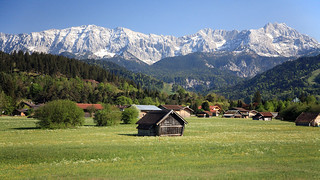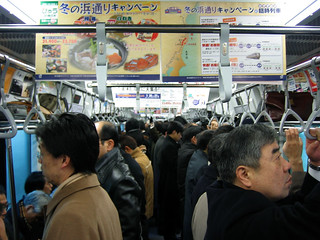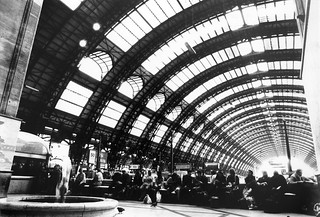

| Archive Blog Cast Forum RSS Books! Poll Results About Search Fan Art Podcast More Stuff Random |
|
Classic comic reruns every day
|
1 {photo of a train station}
1 Caption: Train Travel
|
First (1) | Previous (3287) | Next (3289) || Latest Rerun (2895) |
Latest New (5380) First 5 | Previous 5 | Next 5 | Latest 5 Annotations theme: First | Previous | Next | Latest || First 5 | Previous 5 | Next 5 | Latest 5 This strip's permanent URL: http://www.irregularwebcomic.net/3288.html
Annotations off: turn on
Annotations on: turn off
|
 View seen from train window in Bavaria, Germany. |
It's being inside a little world of its own that moves along with that reassuring clickety-clack of the wheels on the track. On a train, you could be inside a building, with corridors and doors and seats, and sometimes lounge rooms and dining rooms. Except this building is carrying you from your beginning to your destination, with the scenery flashing by the windows outside and the gentle rocking that betrays the motion. The scenery is a parade of places that you will only ever see from the window of a train, perhaps places you have never seen before and will never see again, or perhaps places you see every day, but only from the train.
Trains inhabit an in-between zone of your worldly experience. You slip along the line of the tracks, gaining a cross-sectional view of the world around you. Train lines run through the gleaming hearts of modern cities, through the poor residential neighbourhoods, through rural areas. If you're travelling abroad, you will see more of your destination country from the train than on any other part of your journey. You will see things you never would have seen if you had stayed to the well-trodden tourist paths in the major cities.
 Commuting on Tokyo subway. |
On the train there are other things to do as well. Fellow passengers can be an endless source of diversion. A friend of mine rides the Boston T every day, and posts a Facebook update every day mentioning the unusual or interesting people or clothing or habits she witnesses. This is assisted by riding in the high volume peak commuter periods, and by the fact that T trains are so frequent you just show up at the station and hop on the next one to arrive, meaning your exact travel time (and that of everyone else) varies by a few minutes each day.
My morning commute, on the other hand, runs once every fifteen minutes, so I catch exactly the same train every day, with almost exactly the same set of strangers every day. I can get very familiar with people, their manners, their modes of dressing, their habits, without ever knowing who they are or even speaking to them at all. It's a weird sort of thing.
But long distance trains are a different beast altogether from urban commuter trains. They represent a journey. They hearken back to a time when people crossed the land by coaches, physically covering the intervening terrain, rather than flying over it and not really seeing any of it. Mention train travel and a word that comes into many people's heads is "romantic", in the sense of evoking emotions and a sense of old-fashioned wonder and excitement. A long train trip is exciting in a way that a plane trip never can be.
 King's Cross Station, departure point for the Hogwarts Express. |
The answer is literary. By using a train, Rowling gives the students a stage on which to meet one another and interact. The journey to school becomes important and a vehicle for dramatic content, rather than an eventless blink of the eye. The Hogwarts Express is a closed room where the characters are shut off from the rest of the world for several hours, beyond the easy ken of magic to shuffle them away instantly. Consider how many important exposition scenes take place on the train. Harry's befriending of Ron. Their first meeting with Hermione. The first mention of Nicolas Flamel. The introduction of Neville and the first indicator of his forgetfulness. The reintroduction of Draco Malfoy to the story, which happens in several of the books. The first encounter with Remus Lupin. The first encounter with Dementors. The introduction of Luna Lovegood. Horace Slughorn laying the foundations for another incarnation of his Slug Club. Harry spying on Draco and ending up in a bruising encounter.
 Perth Station, Western Australia. |
Before the Internet and computers and colour television, one of the great joys of childhood was the model train set. From simple wooden blocks with wheels up to sophisticated scale models with electric motors that run on scale tracks. I had an electric train set when I was young, and fantasised over the catalogue from the hobby shop which showed page after page of engines, carriages, freight cars, differently shaped track elements, and scale model scenery. My set never progressed beyond a bare circle, but it didn't stop me dreaming of a room-filling set with multiple loops, switches, and incredibly detailed scenery.
That came flooding back when I happened upon an episode of James May's Toy Stories which covered the Great Train Race, a re-attempt to run a model train over 10 miles of English countryside bicycle path, between Barnstaple and Bideford, in northern Devon. A previous attempt had failed to make the distance, with the train engine wearing out. This attempt was set up as a race between a series of trains along two parallel model tracks laid the entire length of the bike path. With judicious editing, the programme was tense and exciting. It showed how even model trains can captivate and fascinate.
 Milan Station, Italy. |
I have travelled around Italy, from Como in the north to Sicily in the south, by train. The train to Sicily is particularly fascinating, since there is the gap of the Strait of Messina between the island and the Italian mainland. The train from the north arrives at the southern outpost of Villa San Giovanni, across the water from the town of Messina on Sicily. You might expect the train to disgorge its passengers to a waiting ferry, to be picked up by a train on the other side. But no, the train is dismantled as you sit on it, the engines being decoupled from the carriages. The carriages are then shunted on to a large ferry, which has a long compartment fitted with rail tracks. You sit in the carriage, in the dark of the ferry hold, for several minutes as the ferry crosses the strait, and in Messina on Sicily the carriages are hauled out by a new engine and you continue on your way. (The train continued to Palermo, but my destination was Milazzo, the terminus for ferries to the Aeolian Islands.)
 The Meeting, sculpture at St Pancras International Station, London, epitomises the romance of train travel. |
And if Italian trains, with their slightly chaotic operation (resisting even Mussolini's mythical efforts), are memorable, then German trains are awe-inspiring. They really do run on time. They whisk you from place to place with an efficiency which is intimidating, but also refreshing in a world where modern travel is often beset by delays and unpredictability. One thing I recall was waiting for a train at an intermediate stop along the Rhine River. About 15 minutes before it was due to arrive, an extremely apologetic announcement came over the PA system, announcing with great regret and sincere apologies that the train would be arriving one minute late. (I imagine seeing the locals on the platform throwing their hands up in the air and muttering dark and dire imprecations about the parlous state of the German railways these days - but I suspect that's just my own dramatic licence.)
A train can also be a way to travel while relaxing. A flight is (at least for me) always a terrible experience, cramped into a seat with no possibility of rest or sleep, no matter how tired you are. But on a train you can relax. If the journey is overnight, you can get an actual horizontal surface to sleep on without paying through the nose. And it saves a night of accommodation in a hotel as well. There's something to be said for going to sleep as you pull out of your starting place and waking up as you arrive at your destination. It's as if the world has changed around you and there is a bright new day full of new and wondrous things to explore. Arrive by air, and you struggle through the arrival terminal, then have to find transport to where you are going. Arrive by train, and you often arrive right in the heart of the city, with marvellous things to see and do as soon as you step out of the station.
Travel by train, and you really travel.
|
LEGO® is a registered trademark of the LEGO Group of companies,
which does not sponsor, authorise, or endorse this site. This material is presented in accordance with the LEGO® Fair Play Guidelines. |